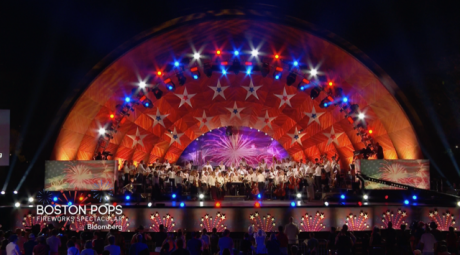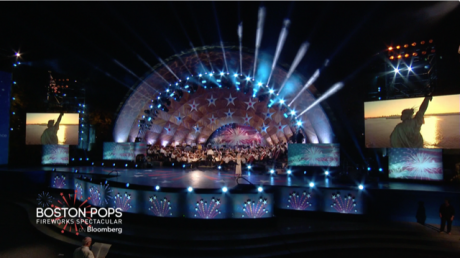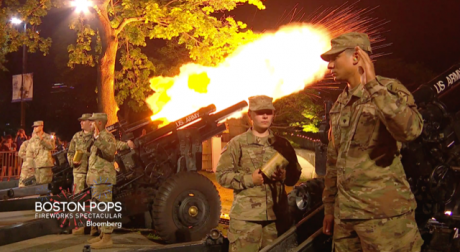 BOSTON -– It’s a July 4th tradition: the “Boston Pops Fireworks Spectacular” at the Edward A. Hatch Memorial Shell on the Esplanade along the banks of the Charles River in Boston. The celebrated orchestra, under the direction of Conductor Keith Lockhart, is one of the biggest annual outdoor concerts in the world. This year Michael Berger of LA-based Full Flood, Inc., utilized Claypaky Scenius Unico and Mythos 2 fixtures and grandMA2 consoles, supplied by 4Wall, to support the production. ACT Lighting, Inc. is the exclusive distributor of both brands in North America.
BOSTON -– It’s a July 4th tradition: the “Boston Pops Fireworks Spectacular” at the Edward A. Hatch Memorial Shell on the Esplanade along the banks of the Charles River in Boston. The celebrated orchestra, under the direction of Conductor Keith Lockhart, is one of the biggest annual outdoor concerts in the world. This year Michael Berger of LA-based Full Flood, Inc., utilized Claypaky Scenius Unico and Mythos 2 fixtures and grandMA2 consoles, supplied by 4Wall, to support the production. ACT Lighting, Inc. is the exclusive distributor of both brands in North America.
More details from ACT Lighting ( www.actlighting.com):
The Independence Day spectacular showcased an all-women guest lineup featuring Emmy award-winning “Fight Song” artist Rachel Platten, Rhiannon Giddens of the Carolina Chocolate Drops, Amy Ray and Emily Saliers of the Indigo Girls, and legendary Emmy, Grammy, Oscar and Tony Awards-winner, Rita Moreno.

The creative brief for the show was to “enhance the natural beauty of the location and to light a concert that starts in full sun and concludes in darkness for the fireworks display. We needed to make the orchestra the star of the show and provide opportunities for the guest artists to shine as well,” says Full Flood’s Michael Berger, a Boston native who marked his third year as Lighting Designer.
“This was a combination symphony orchestra concert and arena rock show held outdoors in the middle of summer,” he notes. “It’s a great opportunity to get to come home to Boston and work on this caliber of show.” The Spectacular was telecast, carried on radio and live streamed by Bloomberg.

Berger utilized Claypaky Mythos 2 fixtures and Scenius Unicos for the production. “Mythos have become an important part of our repertoire,” he says. “For this show they outlined the arch of the Hatch (bandshell) and have developed into a pretty iconic image.”
“Mythos are a staple as a beam unit,” says Lighting Director and Programmer Ryan Tanker. “For the Spectacular the fixtures held up well when hung out of position to create the signature look of the shell.”
Berger used Scenius Unicos for the first time on the production placing the six fixtures in a skytracker position. “It was really important to have their brightness and effects package for this show. I’m eager for a chance to play around with them a bit more to see how else we can use them.”

Tanker cites the speed of the Unicos’ shuttering as a big advantage. “They move so fast, there’s no reaction time,” he says. “They’re great!”
For the first time the production deployed one grandMA2 light and two grandMA2 full-size consoles for lighting control along with 3 8-port Nodes, four 4-port Nodes and a MA 3D previs system. “The grandMA2 offered a lot of features that aligned with the speed at which we had to work and build the show,” Berger notes.
“grandMA2 also had enough on-board processing so we could do the show without NPUs,” adds Tanker. “The amount of processing power available right out of the box was a big factor – and it could always be expanded if needed. Other important factors were the ease of use and workflow. Since this was an outdoor show we spent a lot of time in previs.”
During previs both full-size consoles were in a basement area at the Esplanade running MA 3D; the grandMA2 light, on the same network, was upstairs on stage so Tanker could run up and check things between the previs and the stage.
“Our Network Tech Jason Giaffo was on one full-size console working on the 3D model while I was on the second desk building out the show,” Tanker explains. “He continued to adjust the 3D model as the set was installed in the rain and 100º heat.”
Berger calls MA 3D “a game changer” compared to third-party previs software they’ve used in the past. “Updates and changes are now seamless. It cut our previs time in half.
“One of the aspects I appreciate about grandMA2,” he adds, “is that it’s very much a user-developed console. The ability of programmers to make it their own means that the console serves your purposes in the most efficient way.”
Tanker says he “couldn’t do without Layout Views” for their “ease of use in selections and building out selection orders quickly. There were so many multi-part fixtures on this show, and Layout Views made selections easy and streamlined.”
He also liked the ability to use Special Masters for fixture intensity “starting super bright in daylight and slowly bringing it down through the show as we reached nightfall. A lot was done live with the desk because dress rehearsal was rained out,” Tanker points out. “It was nice to have a lot of Special Masters as we ran live. We could assign them to executions based on groups.”
During focus one full-size system was left in previs and the other was brought out to the field; the grandMA2 light remained on deck. During the show the two full-size consoles ran the show from a tent FOH with the light console as a backup.
“It was a very smooth show,” Tanker reports, “with no network glitches. Everything held up fine.” He gives kudos to Gaffer Eric Norris who ran 900 feet of fiber from the stage through the trees to the FOH tent.


